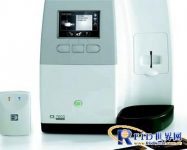
Dental x-rays using RFID technology
[ad_1]
Carestream has introduced a new technology that uses reusable phosphor plates or photos to replace traditional X-ray films. Carestream provides dentistry with new solutions based on RFID technology. RFID technology can associate patients with specific computers. The X images taken by the patients are sent to the associated computer via Wi-Fi wireless network.
RVG 6500 and CS 7600 RFID devices are mainly used to reduce image receiving conflicts and prevent patients’ X images from being received by unrelated computers. With this solution, doctors and patients can see images in a short time, which effectively improves the efficiency of X-ray photography.

The Oakland Beauty Center in Pittsburgh uses Carestream’s RVG 6500 digital X-ray sensor to send X-ray images to a designated computer via a Wi-Fi connection. Paste high-frequency RFID tags on the computer to ensure the efficiency and accuracy of image reception, and you can instantly see whether the captured images are clear.
In February, Carestream released its second set of RFID products, model CS 7600. This solution uses a phosphor plate to replace the film or X-ray sensor, and the image presented by the phosphor plate is consistent with the effect of the traditional X-ray film. The image recorded in the phosphor plate is scanned and stored in the computer and displayed on the screen. A 13.56 MHz label conforming to the ISO 15693 standard is embedded in the phosphor plate. The solution associates the phosphor plate with specific patient information and sends the data to a specific computer. The CS7600 device has a built-in 13.56MHz RFID reader to read the data of the tags in the phosphor plate.
With the aid of the CS 7600 device, the doctor uses a smart board with an RFID tag to grab the patient’s oral photos. Before the smart board is placed in the patient, it is close to the RFID reading device. The tag reader reads the tag’s code and associates it with the patient’s doctor’s name, registration number, etc. stored in the system, and writes this information into the tag. The smart board is placed in the patient, and after the X-ray is taken, it is inserted into the CS 7600 device, which is connected to a computer. The CS 7600 obtains the code of the label and the relevant data of the patient, and sends the image to a specific computer for the doctor to diagnose and treat. The images stored on the smart board can be erased and the board can be recycled.
An RFID reader that complies with the ISO 14443 standard is embedded in the sensing device placed in the patient. Before use, bring it close to the computer where the label is attached to read the code and other information of the label. The computer is used to display the captured image. After the shooting is completed, the sensor device sends the image together with the tag’s code through the wifi network. There are several computers that can detect the signal. How to ensure that only a specific computer (the designated computer in the shooting room) receives the signal? This requires the assistance of RVG6500 equipment. Images can be stored not only in the computer, but also in the hospital’s network system as a backup. If you have special needs, you can download it.
The automatic connection of the RFID solution eliminates the trouble of manual operation by the staff, improves work efficiency, and reduces the risk of cross-infection at the same time.
[ad_2]



